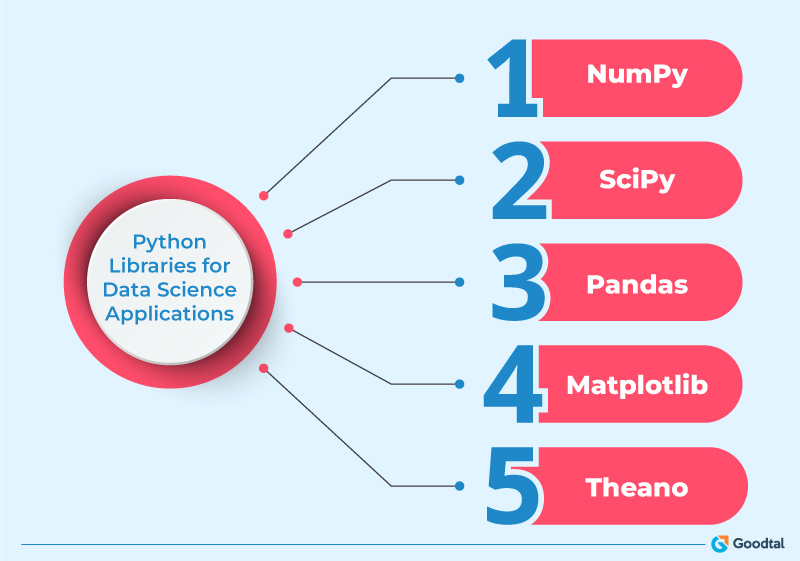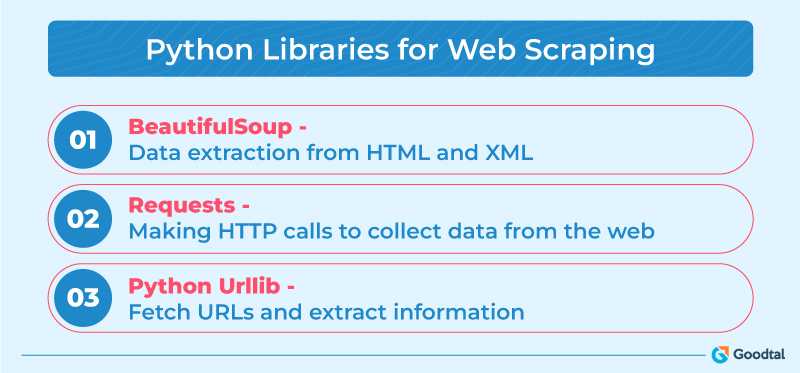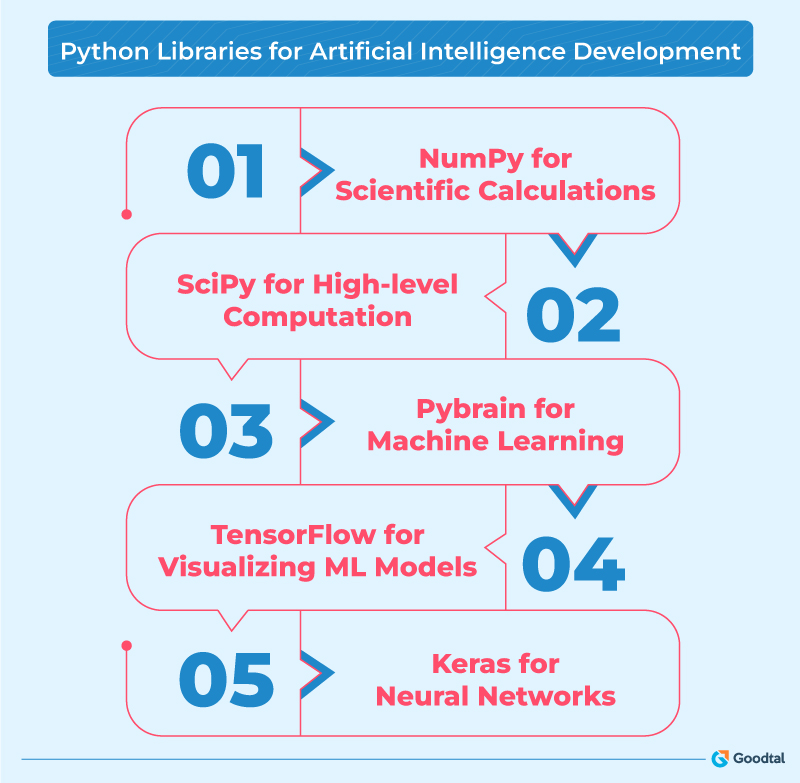
Python is a widely known general-purpose language that software developers prefer for developing a wide range of projects. Most experienced developers explore Python once in their careers while evaluating the best alternatives for their projects. Time and again, you must have heard that Python is not one of the top programming languages now. However, this is not true; despite fluctuating trends, Python bounces back again. It’s time we understand why!
Python Development - Trending Applications!
When you read this blog further, you will also understand why it is important to emphasize in the introduction that Python is suitable for various applications. No wonder! Python stands third among the most used programming languages among developers worldwide.
When we discuss trends, it is essential to cover technology, as software development trends change with changing technologies. Here is a list of the areas where Python contributes heavily to technological trends.
Data Science
If you are in the software development business, you must have heard about the role of Python in Data Science. This is an area Python development companies are exploring like never before. The reason is simple: Python comes with a variety of libraries that support different functionalities and applications in data science.
Here is a list of Python libraries commonly used for Data Science applications.

Web Scrapping
The demand for web scraping is increasing more than ever. Web scraping is one such area adopting Python as you can create scripts for repetitive automotive scraping tasks. As we have already seen, Python is a minimal-code language and has loads of libraries available for a variety of applications, including web scraping. Moreover, Python is compatible with different databases and file formats, which helps web scraping companies access, store, and use scraped data easily.

Python has huge community support that can come to your rescue when you need troubleshooting. So, Python is now widely used for web scraping.
Integration With AI and ML
Python is one of the preferred languages for AI development owing to its readability, platform independence, flexibility, and community support. Python supports the development of Artificial Intelligence and Machine Learning with its rich libraries that offer development opportunities for so many AI functions. Here are some Python libraries for AI development.

Python is expected to be a tough competitor of C++ and Java in AI and ML, and Artificial Intelligence developers must thus leverage the capabilities of Python for success in this domain.
IoT and Edge Computing
The world is changing fast with technology. The Internet of Things is making our cities smart. IoT is a big deal as it aims at connecting a network that spans huge cities, including a large number of people, services, hardware, software, and the channels that help in communication between them.
Internet of Things developers work with various hardware, software, and protocols. If the tools and technology are easy to understand and implement across the project, they can make highly scalable and complex projects with it. Remember, IoT is about scale and it requires edge-computing for integrating varied hardware, software, devices, and systems into one network.
The selection of hardware and software for IoT should be such that it facilitates real-time communication, as well as integration with such a complex system. So, the languages and frameworks should be selected with caution.
Python is cross-platform, readable, and easy to grasp. This is the reason why Python is a good choice for IoT. Moreover, Python supports a variety of hardware and OS that are used for implementing IoT. IoT requires data processing in large volumes.
Python is popular for data applications, including AI-based edge computing that facilitates real-time decision-making in IoT. However, if you ask me whether Python is the best choice for IoT programming, I would say NO!
IoT is under research and development; we are still experimenting with the use of Python in IoT development. There is no best choice of language or framework yet, and soon, the developers will be able to decide that based on the success of existing IoT applications. Till then, be ready to explore!
Suggested Reading: Top 10 Applications Of Python Programming Language
Challenges in Python Development
Python could be easy to learn or code and comes with a variety of libraries that aid in developing complex functionality. However, not all developers choose Python; read further to know why!
Performance
There are many languages available for software development, including Java, C++, PHP, JavaScript, C, GoLang, etc. Each has its merits, and so none of these can be absolutely considered perfect compared to the others. For example, Python is considered slower compared to C, C++, and Java.
Python Global Interpreter Lock (GIL) allows only one thread to execute simultaneously, hindering multi-thread code execution performance. So, applications that are very demanding on performance require languages that can perform faster, and Python is not a very good choice for these.
Scalability
As we discuss performance, we can also deduce that Python is not suitable for a very high level of scalability that would consequently require high performance. However, applications that may not require such levels of scalability are possible and feasible with Python.
Python is also high on memory consumption, making it heavy for handling large data sets or long-running processes. So, it is not wise to use Python for projects demanding scalability.
Debugging
Though Python is readable, debugging is still difficult with Python. In a dynamically typed language like Python, the variable types are determined at runtime. So typing errors are difficult to identify during debugging and these can become a problem during runtime.
Testing
Though the availability of third-party libraries helps in developing varied functionality, testing is challenging with these third-party libraries. However, the challenge can be overcome easily by hiring the best software testing services.
Python Development Tips
Finally, let’s look at some tips for successful Python development.
Naming Functions and Variables
This is one of the first tips that determine good coding, yet many developers ignore the significance of naming functions and variables relevantly. Meaningful variable names and function names make the code easy to understand.
Optimizing Functions
No matter which programming language you use, functions should be as short and simple as possible and focused on specific outcomes. There can be multiple functions to accommodate complex and multiple functionality. This makes the code more readable and easy to understand, debug, or modify.
Practice Code Review
Code review is an essential part of effective software development, though some development companies skip it to save time and resources. Developers must strictly follow code review and assign different developers for coding and reviewing to get varied perspectives. This encourages knowledge sharing and improves the overall quality of the application.
Suggested Reading: What Software Developers Must Know About Code Review for High-Quality Software Development
Continuous Learning
Most of the top programming languages upgrade very often. Developers must keep learning new concepts and techniques to code better with changing needs and market conditions. The more you learn and practice with Python, the better will be your experience and expertise.
Employ Version Control
Managing code versions has always been a challenge for developers. So, employing version control systems to track changes helps manage and preserve versions. This also aids in better collaboration and a smooth transition from one stage to another.
Documentation
No matter how good you are in software development, if you ignore documentation, your software will be hard to manage in the long run. Comprehensive and effective documentation is a very crucial part of software development, be it before the first release or even at the time of updates.
Follow the Trends
Following the trends is a significant tip for software development. Developers worldwide are leveraging Python in different ways to build simple to complex applications. One must read blogs on Python development, be a part of the Python community online, and try to keep up with the latest in Python development. However, do not follow a trend blindly without assessing whether it matches your requirements. Feasibility analysis is a must in adopting anything!
Hire the Top Python Developers
Last but not least, the perfect tip for successful Python development is to outsource your Python application development to experienced Python development agencies who have developed a variety of projects in Python.
Don’t forget to check the reviews and ratings of the Python development companies before you select the one that matches your budget and requirements. However, also remember that you will need to assign a reasonable budget for hiring better and more professional Python developers who can ensure a successful application.
Suggested Reading: What Does the Future Hold for Software Development in 2023 and Beyond?
Wrapping Up!
Python development companies worldwide are taking up new challenges and leveraging this language for a wide variety of applications. If you are planning to explore Python for your next software development project, go ahead! However, if you want exceptional results and a product that meets your expectations, hiring the best Python developers who are specialists in the field is better.
